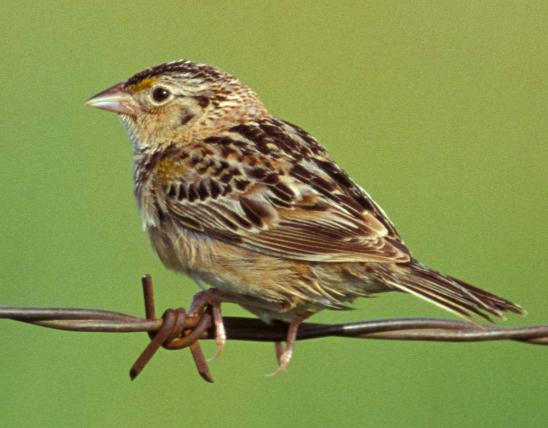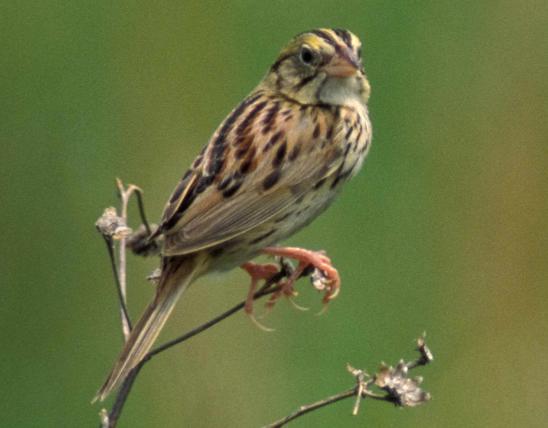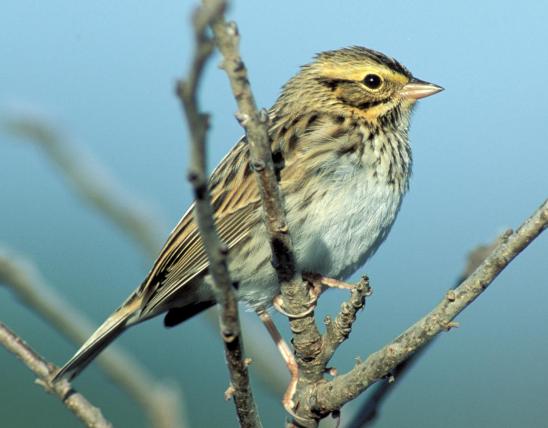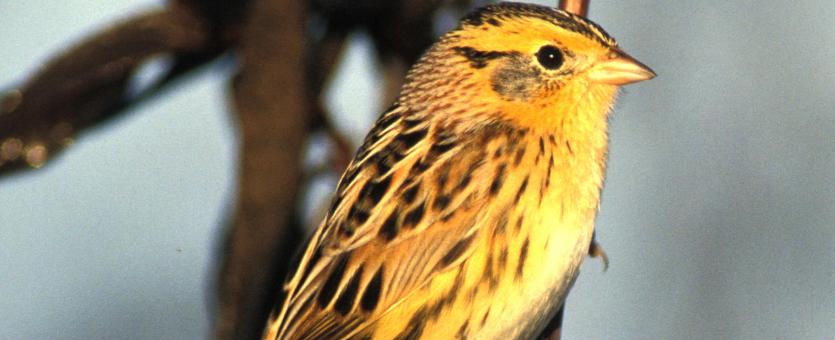
Le Conte's sparrow adult upperparts are streaked with black and buff on the back; the crown is dark brown with a narrow white central crown stripe. Eyebrow is broad, orange-buff; there is a narrow, dark eye line; the cheek and nape are gray, with chestnut streaking on the nape. Underparts are white, with a broad, orange-buff breast band and dark steaks on the sides and flanks. This is a short- and sharp-tailed, weak-flying species. Young are duller, with pale back stripes, and faint streaking on the breast. Song is high pitched and buzzy with ticking sounds at either end, but is seldom heard in Missouri.
Similar species: Note this sparrow's flat-headed profile, and remember to consider habitat and time of year. This species likes open, grassy, brushy places, and is absent from Missouri during the summer. Grasshopper sparrows are in similar habitats but are here during summers; they are tanner, lacking the orange cast, and adults are not streaked on chest and flanks. Henslow's sparrow, too, is a summertime grassland sparrow lacking the orangish cast; it has an olive-green head, and chestnut on the upperparts. Dickcissels, too, are summertime grassland birds; they have yellow (not orange) eyebrows and are larger, with a different body shape, and males have black bibs (even the females and young show some blackish marks on the throat or dark lines edging the sides of the throat).
Length: 5 inches (tip of bill to tip of tail).
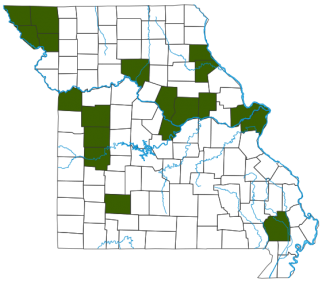
Potentially statewide, in appropriate habitats and seasons.
Habitat and Conservation
As a migrant in the spring and fall, this secretive bird is usually found in prairies, prairie grass plantings, and weedy fields. In winter, look for it in brushy, moist fields and meadows, mostly in the southern portion of the state. It is often difficult to observe; try looking for it in early morning or with a group of patient observers. Just after dawn, Le Conte's sparrows will often perch on tall plants or shrubs and can be closely observed. When you draw near, they may fly weakly away for 10–20 yards and drop into the grass again, out of sight. If you have a group of 5–10 people, and you flush one, watch to see where it drops from sight. Then, have everyone quickly circle the area, about 10 yards away from the bird. Then, slowly, everyone takes a step and pauses, gradually moving toward the landing spot. At some point, usually with about 15–20 feet to go, you will see a motion in the grass: try to get a good look. Do not approach any closer until everyone gets a look, or the bird stays still for 5 minutes. If the bird stays hidden, move up by half steps until the sparrow moves again. To keep the bird from finding an easy exit, keep the circle as evenly spaced as possible until everyone gets a chance to see. Then, open up the circle and watch as it flies away.
Food
Le Conte's sparrows forage on the ground for insects and seeds in prairies or warm-season grass plantings. Like many birds, the diet during breeding season includes a greater percentage of insects and spiders. In winter, they shift more to grass and weed seeds.
Status
As a transient (or migrant), common in western Missouri and uncommon in the east; as a winter resident, uncommon in the south, rare in the north (the Glaciated Plains). John James Audubon discovered this species and named it after a friend of his, but it is not known for certain which of two John LeContes he meant to honor. One was an eminent entomologist, famous for his studies of beetles, who collected the first Le Conte's thrasher known to science; the other was his cousin, also a scientist.
Life Cycle
Le Conte's sparrows arrive in Missouri in early October, and their numbers peak the second half of that month due to the many migrants passing through. Another peak occurs in late March and early April, as the migrants head back north. By the end of April, they are gone from our state. Their nesting territory includes the Dakotas, Minnesota, and Wisconsin, and north through most of central Canada. They build cup nests out of grasses, positioned on a cluster of dead grasses, at ground level or slightly higher. Clutches comprise 2–6 eggs. The oldest Le Conte's sparrow lived to be at least 4 years old.
Human Connections
Birding is fun, active, and even competitive; it's invigorating for both mind and body. Birders hike in natural places at dawn, witnessing beautiful, wild sights that sleepyheads miss. They create "life lists" of all the birds they've seen and heard, and they compete to see who has the longest list, with the rarest, hardest to spot, or hardest to identify species. If going to a gym sounds boring to you, maybe you should check out your local Audubon club.
Ecosystem Connections
Birds that nest and forage near the ground are usually well camouflaged and have behaviors that help them escape notice or capture. Le Conte's quick flight when approached, and when surrounded, reluctance to be flushed, are adaptations to ages of predation pressure.
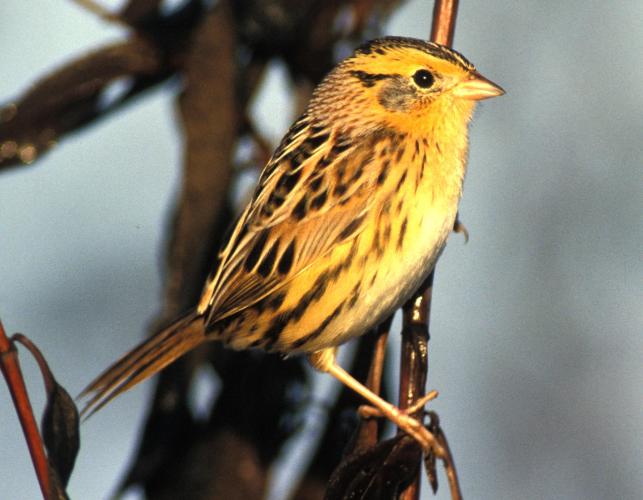
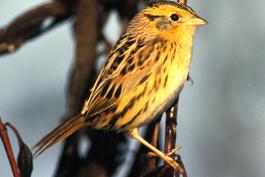
About 350 species of birds are likely to be seen in Missouri, though nearly 400 have been recorded within our borders. Most people know a bird when they see one — it has feathers, wings, and a bill. Birds are warm-blooded, and most species can fly. Many migrate hundreds or thousands of miles. Birds lay hard-shelled eggs (often in a nest), and the parents care for the young. Many communicate with songs and calls.






















